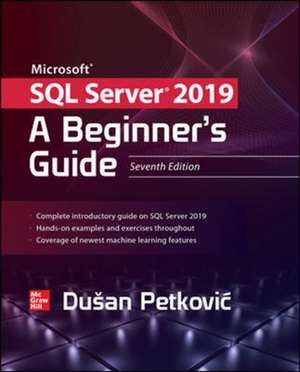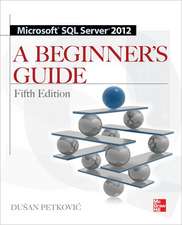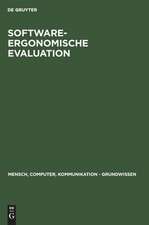Microsoft SQL Server 2019: A Beginner's Guide, Seventh Edition
Autor Dusan Petkovicen Limba Engleză Paperback – 28 ian 2020
Get Up to Speed on Microsoft® SQL Server® 2019 Quickly and Easily
Start working with Microsoft SQL Server 2019 in no time with help from this thoroughly revised, practical resource. Filled with real-world examples and hands-on exercises, Microsoft SQL Server 2019: A Beginner’s Guide, Seventh Edition starts by explaining fundamental relational database system concepts. From there, you’ll learn how to write Transact-SQL statements, execute simple and complex database queries, handle system administration and security, and use powerful analysis and reporting tools. New topics such as SQL and JSON support, graph databases, and support for machine learning with R and Python are also covered in this step-by-step tutorial.
- • Install, configure, and customize Microsoft SQL Server 2019
• Create and modify database objects with Transact-SQL statements
• Write stored procedures and user-defined functions
• Handle backup and recovery, and automate administrative tasks
• Tune your database system for optimal availability and reliability
• Secure your system using authentication, encryption, and authorization
• Work with SQL Server Analysis Services, Reporting Services, and other BI tools
• Gain knowledge of relational storage, presentation, and retrieval of data stored in the JSON format
• Manage graphs using SQL Server Graph Databases
• Learn about machine learning support for R and Python
Preț: 206.14 lei
Preț vechi: 290.78 lei
-29% Nou
Puncte Express: 309
Preț estimativ în valută:
39.45€ • 41.37$ • 32.84£
39.45€ • 41.37$ • 32.84£
Carte tipărită la comandă
Livrare economică 03-09 aprilie
Livrare express 25 februarie-01 martie pentru 86.42 lei
Preluare comenzi: 021 569.72.76
Specificații
ISBN-13: 9781260458879
ISBN-10: 1260458873
Pagini: 864
Dimensiuni: 185 x 231 x 48 mm
Greutate: 1.23 kg
Ediția:7
Editura: McGraw Hill Education
Colecția McGraw-Hill
Locul publicării:United States
ISBN-10: 1260458873
Pagini: 864
Dimensiuni: 185 x 231 x 48 mm
Greutate: 1.23 kg
Ediția:7
Editura: McGraw Hill Education
Colecția McGraw-Hill
Locul publicării:United States
Cuprins
PART 1: Basic Concepts
Chapter 1: Relational Database Systems: An Introduction
Chapter 2: Installation of SQL Server
Chapter 3: Front-end Systems of SQL Server
PART 2: Transact-SQL Language
Chapter 4: SQL Components
Chapter 5: Data Definition Language
Chapter 6: Queries
Chapter 7: Modification of a Table's Contents
Chapter 8: Stored Procedures and User-Defined Functions
Chapter 9: System Catalog
Chapter 10: Indices
Chapter 11: Views
Chapter 12: Security System of the Database Engine
Chapter 13: Concurrency Control
Chapter 14: Triggers
PART 3: System Administration
Chapter 15: System Environment of the Database Engine
Chapter 16: Backup, Recovery and System Availability
Chapter 17: Automating System Administration
Chapter 18: Data Replication
Chapter 19: Query Optimizer
Chapter 20: Performance Tuning
Chapter 21: In-Memory OLTP
PART 4: Business Intelligence
Chapter 22: Business Intelligence: An Introduction
Chapter 23: SQL Server Analysis Services
Chapter 24: Business Intelligence and Transact-SQL
Chapter 25: SQL Server Reporting Services
Chapter 26: Optimizing Techniques for ROLAP
Chapter 27: Columnstore Indices
Chapter 28: Intelligent Query Processing
PART 5: Beyond Relational Data
Chapter 29: SQL/JSON Support
Chapter 30: Spatial and Temporal Data
Chapter 31: Graph Databases
PART 6: Machine Learning
Chapter 31: Support for R
Chapter 32: Support for the Python Language
Chapter 1: Relational Database Systems: An Introduction
Chapter 2: Installation of SQL Server
Chapter 3: Front-end Systems of SQL Server
PART 2: Transact-SQL Language
Chapter 4: SQL Components
Chapter 5: Data Definition Language
Chapter 6: Queries
Chapter 7: Modification of a Table's Contents
Chapter 8: Stored Procedures and User-Defined Functions
Chapter 9: System Catalog
Chapter 10: Indices
Chapter 11: Views
Chapter 12: Security System of the Database Engine
Chapter 13: Concurrency Control
Chapter 14: Triggers
PART 3: System Administration
Chapter 15: System Environment of the Database Engine
Chapter 16: Backup, Recovery and System Availability
Chapter 17: Automating System Administration
Chapter 18: Data Replication
Chapter 19: Query Optimizer
Chapter 20: Performance Tuning
Chapter 21: In-Memory OLTP
PART 4: Business Intelligence
Chapter 22: Business Intelligence: An Introduction
Chapter 23: SQL Server Analysis Services
Chapter 24: Business Intelligence and Transact-SQL
Chapter 25: SQL Server Reporting Services
Chapter 26: Optimizing Techniques for ROLAP
Chapter 27: Columnstore Indices
Chapter 28: Intelligent Query Processing
PART 5: Beyond Relational Data
Chapter 29: SQL/JSON Support
Chapter 30: Spatial and Temporal Data
Chapter 31: Graph Databases
PART 6: Machine Learning
Chapter 31: Support for R
Chapter 32: Support for the Python Language













